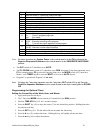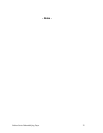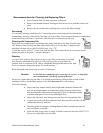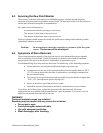
Cabinet Series Dehumidifying Dryer 36
Recommendations for Cleaning and Replacing Filters
• Turn off and/or lock out electrical power to the dryer.
• Remove the threaded fastener securing the filter access cover, and then remove the
cover.
• Remove the nut on the center retaining rod to remove the filter cartridge.
Vacuuming
Try vacuum-cleaning a soiled filter first. Vacuuming removes most large particles and surface
contaminants, and may suffice for the first time you clean a filter. Use a commercial-duty (recommended)
or household vacuum cleaner. Vacuum the filter from the air intake (dirty) side only.
Cleaning with Compressed Air
Blow clean, dry compressed air up and down the pleats, blowing out the filter from the clean
side. Remove loose dirt from the filter with compressed air or a water hose. Compressed air
should be less than 100 psi (689.5 kPa/6.89 bars). Use a
1
/8”
(3 mm) dia. nozzle at least 2” (5 cm) away from the filter. Don’t shoot the air in a crisscross motion
against the grain of the pleats—you may damage it.
Washing
As a last resort, wash the filter. However, do so only if the pressure drop is too high
from fine dirt embedded in the filter, or if oily mist is present near the intake air
location. Soak in a solution of FM 1400 or comparable detergent and warm water from
five to ten minutes, then gently agitate for several minutes.
Rinse thoroughly with clean water to remove all detergent.
Caution! Let the filter dry completely before returning it to service! A damp filter
can contaminate the closed loop system of the dryer.
Do not use a light bulb to dry the filter. You should get satisfactory filtration after second or third
washings; however, dirt-holding capacity of the filter decreases after each washing.
After each cleaning:
• Inspect the filter element. Briefly hold a light bulb behind the element and
look for any fatigued paper or residual dirt. Inspect for holes and tears by
looking though the filter toward a bright light. Check for damaged gaskets
or dented metal parts. Do not re-use a damaged filter!
• Inspect the end plates. Any damage here can allow air to bypass the filter.
• Look for rust on the end plates and metal core. Rust particles can flake off and
contaminate the dryer and resin.
• Check the gasket for damage. A damaged gasket allows contaminants into the
process. Replace as needed.
• Allow the filter to dry before re-using. Circulate warm air at less than 160ºF (71ºC).
Do not use a light bulb to dry the filter.


















